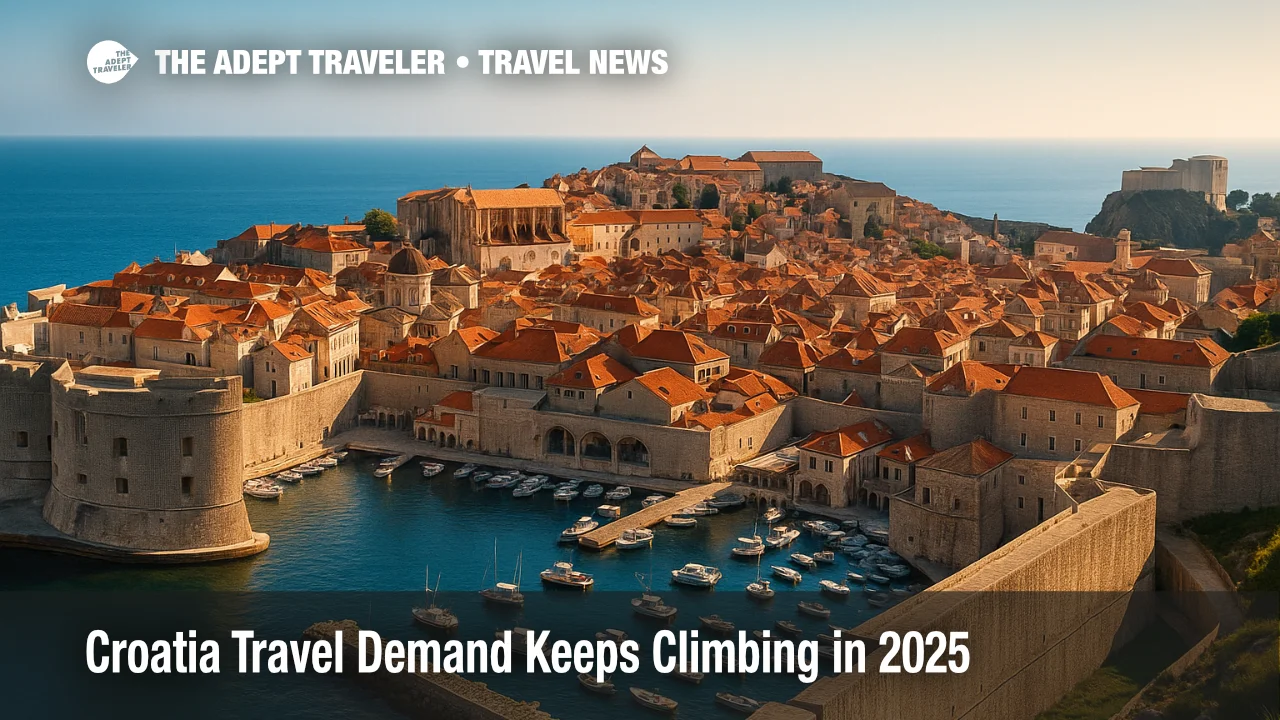Croatia travel demand keeps climbing in 2025**

Croatia travel momentum is accelerating across the Adriatic and inland hubs as the country rolls past a record 2024 and posts stronger shoulder seasons in 2025. Official tallies show arrivals and nights rising, with spending also up. Airlines are adding capacity into Zagreb, Split, and Dubrovnik, while local destinations invest in crowd management and conservation. The combined effect is a broader, longer season that is drawing more U.S. travelers and first-time visitors from across Europe.
Key Points
- Why it matters: Croatia travel is growing beyond peak summer, lifting access, reliability, and value.
- Travel impact: More flights and extended seasons strengthen options for Zagreb, Split, and Dubrovnik trips.
- What's next: Expect continued route tweaks and dispersion measures as arrivals set fresh records in late 2025.
Snapshot
Croatia recorded 21.3 million visitors in 2024, up about 4 percent year over year, and more than 108 million overnight stays. Through August 20, 2025, officials reported 15.5 million arrivals and 79.2 million nights, both edging above 2024, alongside a double-digit jump in tourist spending. Airports mirrored the trend, with July 2025 passenger traffic up 5.5 percent nationwide, led by Split Airport (SPU) and Dubrovnik Airport (DBV). Croatia Airlines lifted summer capacity and unveiled additional seasonal routes from Zagreb Franjo Tuđman Airport (ZAG). Together with conservation-funded site management in Dubrovnik and new conduct rules in Split and Hvar, the country is nudging growth into a more sustainable, year-round model.
Background
Croatia adopted the euro and joined the border-free Schengen Area on January 1, 2023, simplifying payments and overland movement, which officials credit with boosting travel in 2023 and beyond. That integration helped sustain momentum through 2024's record year. In parallel, national statistics offices and the eVisitor system show continued gains in arrivals and nights, supported by expanding air service and diversified accommodation. The government and local partners have also leaned into dispersion, encouraging travelers to explore beyond the classic Dalmatian Coast peaks and into the shoulder months.
Latest Developments
Airports log new peaks as carriers add capacity
Passenger throughput rose again in mid-2025, with July totals up 5.5 percent nationwide. Split Airport (SPU) handled about 783,000 passengers in July, Dubrovnik Airport (DBV) about 538,000, and Zagreb Franjo Tuđman Airport (ZAG) roughly 467,000. Croatia Airlines increased summer flying by about 7 percent versus 2024 and launched new seasonal routes from ZAG, while its A220 fleet renewal supports better schedules and operating economics. These capacity moves, concentrated in the extended peak and shoulders, are critical to sustaining growth without overloading single weekends in July and August.
U.S. demand climbs into the top five markets
American interest keeps rising. Mid-June 2025 readings showed more than 260,000 U.S. arrivals and nearly 690,000 overnights year to date, putting the United States among Croatia's top five source markets. Dubrovnik's nautical segment also reported U.S.-led gains through August. For planners, this means more English-language product, stronger long-haul connectivity via European hubs, and growing premium inventory in Dubrovnik, Split, and Zagreb.
Local stewardship, rules, and reinvestment
Destinations are pairing growth with management. Dubrovnik channels City Walls ticket revenue into restorations, while Split and Hvar enforce fines for nuisance behavior. These policies aim to protect heritage sites, keep historic cores livable, and preserve traveler experience as volumes climb. For practical guidance on these measures, see our coverage of Dubrovnik City Walls revenue powers restorations and Croatia Targets Rowdy Tourists with New Split and Hvar Fines.
Analysis
Croatia's growth story rests on three pillars. First, friction fell after euro and Schengen integration, reducing border and payment hassles for Europeans and simplifying pricing for long-haul visitors. Second, the air network is maturing. Even without many nonstop U.S. flights, increased frequencies into ZAG, SPU, and DBV, plus efficient connections over European hubs, improve reliability and fare competitiveness. Third, policy and product changes are spreading demand. Conservation reinvestment in Dubrovnik and behavior rules in Split and Hvar shape traveler flow, while emerging product inland and in shoulder months lengthens stays and raises average spend. Risks include price sensitivity on the coast, uneven capacity between peak weeks and spring or fall, and infrastructure pressure on narrow heritage corridors. But with airports scaling, a refreshed national carrier, and steady U.S. interest, Croatia's outlook into late 2025 and 2026 remains constructive for leisure travel and small-ship cruising.
Final Thoughts
If you are weighing a Croatia travel plan, consider spring or fall for calmer Old Towns, easier dining reservations, and dependable air options via European hubs. Lock in Split or Dubrovnik for the coast, add Zagreb for museums and food, then layer in Istria or the islands for depth. Monitor local rules, reserve key sites in advance, and watch for seasonal route updates that can shave time and layovers. The ingredients are aligning for a balanced, longer season, which is why interest in Croatia travel continues to rise.
Sources
- Croatia records 21.3 million visitors in 2024, a 4% rise, Croatian National Tourist Board
- Croatia's tourist arrivals rise 4% in 2024, ministry says, Reuters
- Croatia reports record tourist arrivals so far in 2025, Reuters
- Croatian airports passenger traffic up 5.5% in July, SeeNews
- Croatia Airlines presents new international routes, Croatia Airlines
- Summer 2025, Croatia Airlines, EX-YU Aviation
- Croatia's rising popularity among American tourists, CroatiaWeek
- United States leads growth in Dubrovnik's nautical tourism, The Dubrovnik Times
- Croatia rings in New Year as fully integrated EU member, AP News
